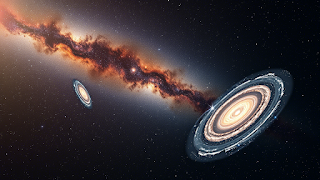How Big is the Universe? A Journey Through Space
Earth, our home planet, is a tiny blue dot floating in the vast cosmic ocean. Every human who ever lived, every story ever told, and everything we know exists here. But as we zoom out beyond Earth’s atmosphere, past the Moon, the planets, and our Sun, we embark on an incredible journey to grasp the true scale of our universe.
---
The Moon – Our First Stop
The Moon, Earth's closest celestial neighbor, is about 384,000 kilometers away. To put this into perspective, if you were to drive a car at 100 km/h, it would take over 160 days to reach the Moon. From this distance, Earth appears as a small, fragile sphere floating in the vast emptiness of space.
The Sun – The Heart of Our Solar System
The next major landmark in our journey is the Sun, which lies about 150 million kilometers (1 Astronomical Unit, AU) from Earth. Light, traveling at 300,000 km per second, takes 8 minutes and 20 seconds to reach Earth from the Sun. If we traveled this distance in a commercial airplane flying at 900 km/h, it would take 19 years to reach the Sun.
The Sun, a gigantic ball of burning plasma, provides the energy necessary for life on Earth. Even within our solar system, the vast distances reveal the immense scale of space.
---
Mars – The Red Planet
Mars, often called our "red neighbor," is 54.6 million kilometers away at its closest and 401 million kilometers away at its farthest. If we traveled to Mars at the speed of a commercial airplane, it would take over 50 years to reach it. These enormous distances pose significant challenges for space exploration.
The Edge of the Solar System – Neptune and Beyond
Neptune, the farthest planet in our solar system, is 4.5 billion kilometers away from Earth. Sunlight takes 4 hours and 15 minutes to reach Neptune. Beyond Neptune lies the Oort Cloud, a theoretical region filled with icy objects, stretching up to 1.9 light-years from the Sun.
 |
| Voyager 1 (1977) |
One of the most remarkable space missions, Voyager 1, was launched in 1977 and has traveled over 22 billion kilometers from Earth. In 1990, it captured the famous Pale Blue Dot image, showing Earth as a tiny speck in the vastness of space.
---
Interstellar Space – The Journey to Other Stars
Beyond our solar system, we enter interstellar space. The closest star system to us is Alpha Centauri, located 4.4 light-years away. At current space travel speeds, it would take over 70,000 years to reach Alpha Centauri, highlighting the unimaginable scale of the cosmos.
---
The Milky Way Galaxy – Our Cosmic Home
Our galaxy, the Milky Way, spans 100,000 light-years and contains hundreds of billions of stars. Within it lies a small sphere called the human radio bubble, extending 100 light-years from Earth—representing the farthest reach of our radio signals. Beyond this, the vast majority of the galaxy remains unaware of our existence.
Intergalactic Space – A Universe of Galaxies
Leaving the Milky Way, we enter intergalactic space, where galaxies float like islands in an endless ocean. Our Milky Way is part of the Local Group, a cluster of over 50 galaxies spread across 10 million light-years.
Beyond the Local Group lies the Virgo Supercluster, a massive region of space containing thousands of galaxies across 110 million light-years. Even larger is the Laniakea Supercluster, which spans 500 million light-years and contains 100 million billion Suns.
The Observable Universe – A Mind-Boggling Scale
The observable universe stretches 93 billion light-years in diameter. Despite being only 13.8 billion years old, the universe has expanded due to cosmic inflation, pushing galaxies further apart.
But what lies beyond the observable universe? Scientists believe the universe may be infinite, containing regions we will never see as they move away faster than the speed of light.
---
A Humbling Perspective
As we explore the universe, we realize how small we truly are. Our planet, our galaxy, and even our entire supercluster are just tiny specks in the grand cosmic expanse. The universe is vast, mysterious, and ever-expanding, leaving us with the humbling realization that there are infinite wonders we may never witness.
---
Final Thoughts
Despite our smallness, Earth remains our only home. The vastness of the universe reminds us to cherish our planet and continue exploring the mysteries of space. Who knows what lies beyond the stars?
---










Good info
ReplyDelete